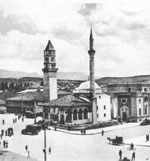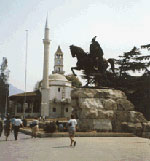
Tirana's Skënderbeu Square in the late 1920s

FRONT PAGE
About us

The 2010 results
The 2010 project
The 2010 finalists
Code of Ethics
The World Mayor Prize

The 2008 results
The 2008 project
The 2008 finalists
The World Mayor Award

The 2006 results
Methodology
The 2006 finalists
The World Mayor Award

The 2005 results
Contest methodology
List of finalists
Mayor Rama writes - Mayor Bakoyannis replies

The 2004 contest
List of all 2004 finalists
Edi Rama wins 2004 award
People ask - Edi Rama replies
Why we voted for the Mayor of Tirana
Why we voted for the Mayor of Mexico City
History of Tirana

Front Page
Site Search
About City Mayors
The history of Tirana a fusion of
Islamic and Christian influences
By Nick Swift
Tirana, the capital of Albania, is an ancient city with an early history enriched by the interplay of cultural forces originating in the Islamic and European Christian worlds.
There are a number of hypotheses concerning the origin of the name.
One is that it is from the word ‘Theranda’ that Greek and Latin sources employ to refer to the area, after the term ‘te ranat’ used by the inhabitants, meaning ‘fallen material’, in reference to the composition of the terrain out of hard earth swept down by water from the nearby mountains.
It is from ‘Tirkan’, the name used by the sixth century Byzantine historian Prokop to refer to a castle, first built in the first century BC, on Mount Dajti, and the ruins of which are extant.
It is from ‘tyros’, the old Greek word for ‘dairy’, on the hypothesis that it was in the field there that the shepherds of surrounding areas gathered to trade dairy products.
An often-repeated explanation is that ‘Tirana’ was so named by Sulejman Pasha, the Turkish military leader at the time of Turkey’s conquest of Persia in the 17th century, after Tehran, the capital of Persia (now Iran). Such a theory would, however, seem to be contradicted by the evidence of Tirana’s name in its current form appearing in a 1418 Venetian document.
A further ‘spin’ on the Sulejman Pasha idea is that when he was at the location of what became the city of which he is considered to have been the founder, he came across an elderly woman who, when he asked her what she was doing, replied, ‘Po tir an’: ‘spinning silk’.
Records of the first land registrations under the Ottomans in 1431-32 reveal that Tirana then consisted of 60 inhabited areas, with nearly 1000 houses and 7300 inhabitants.
Marin Barleti, the first to write a history of Albania (and himself of Albanian descent), tells us that in the 15th century there were ‘Tirana e Madhe’ and ‘Tirana e Vogël’ (Great and Small Tirana). Barleti, a Catholic priest and scholar, was largely responsible, through his biography of him, for creating what became the cult of Iskander Bey, the title (in Turkish) (rendered in Albanian as ‘Skenderbeu’, and frequently anglicized as ‘Skanderbeg’) given to Gjergj Kastrioti, an Albanian nobleman who, after being forcibly brought to Adrianople as a youth and given military training, distinguished himself in a number of campaigns for the Ottomans, and was promoted to the rank of general, but then returned to Albania to liberate it, and spent the next 25 years, until his death, leading a successful guerilla resistance against the forces of the Turkish empire. Skenderbeu continues to be the national hero of Albania.
The 1583 registration records inform us that at that time Tirana had 110 inhabited areas, 2900 houses and 20,000 inhabitants.
When Sulejman Pasha established the city in 1614, his first constructions were a mosque, a bakery and a hamam (Turkish sauna).
Two centuries later, control of the city was won by the Toptani family of Kruja. It was noted that the two oldest neighbourhoods were Mujos and Pazari, between the geographical centre and Elbasani Street, on either side of the Lana River.
In 1703 Tirana had 4000 inhabitants.
In 1769 Tirana and its environs exported 2600 barrels of olive oil and 14,000 packages of tobacco to Venice.
In 1820 Tirana had 12,000 inhabitants.
In 1901 its population was 15,000. It had 140,000 olive trees, 400 oil mills, and 700 shops.
In 1938 Tirana’s population had grown to 38,000.
By 1945 it had 60,000 inhabitants.
The construction, by the best artisans in the country, of the mosque in the centre of Tirana, called the Mosque of Ethem Beu, was begun in in 1789 by Molla Beu of Petrela (a locale in Albania). It was finished in 1821 by his son, who was also Sulejman Pasha’s grand-nephew. The Clock Tower was started by Haxhi Et’hem Beu around 1821-22, and was finished with the help of the richest families of Tirana. Its installation was the work of the Tufina family. In 1928 the Albanian state bought a modern clock in Germany, and the tower was raised to a height of 35 metres. The clock was damaged during World War II, but was restored to full function in July 1946.
The Orthodox Church of Saint Prokop was built in 1780.
The Catholic Church of Saint Maria was constructed in 1865 at the expense of the Austrian-Hungarian Emperor, Franc Josef. The Tabakëve and Terzive bridges (respectively in front of the Parliament building and on Elbasani Street) date from the beginning of the 20th century. The mosque that is also the tomb of Kapllan Hysa (near the monument to Ushtari I Panjohur (‘the unknown soldier’)) was built in 1816.
The Library was established in 1922, with 5000 volumes.
The Fortress of Petrela, 12 kilometres from Tirana, dates from the fourth century BC. It took its current form in the 13th century, under the rule of Topiaj, and later became the property of the Kastriotis.
On 8 February, 1920 Tirana was made the temporary capital by the Congress of Lushnja, and acquired that status permanently on 31 December, 1925.
Since 1925, when they were banned in Turkey, Tirana has been the primary centre in the world of the Bektashis, an order of dervishes who take their name from Haji Bektash, a Sufi saint of the 13th and 14th centuries. (It was the same Haji Bektash who blessed the Janissaries, the famed Ottoman fighting corps that originally comprised non-Muslim conscripts, many of them Albanians.)
The first regulatory plan of the city was compiled in 1923 by Estef Frashëri. Durrësi Street was opened in 1922, and was called Nana Mbretneshë (Mother Queen). Many houses and surrounding properties were demolished to make way for it. The existing parliamentary building was raised in 1924, and first served as a club for officers. It was there, in September 1928, that Ahmet Zogu proclaimed the monarchy.
The centre of Tirana was the project of Florestano de Fausto and Armando Brasini, well known architects of the Mussolini period in Italy. The Palace of Brigades (of the former monarch), the ministries buildings, the National Bank and the Municipality are their work.
The Dëshmoret e Kombit (National Martyrs) Boulevard was built in 1930 and given the name Zogu I Boulevard. In the communist period, the part from Skënderbej Square up to the train station was named Stalin Boulevard.
The Palace of Culture (Pallati I Kulturës), where the Theatre of Operas and Ballet and the National Library stand, was completed in 1963 on the site of the former Trade of Tirana building, with the first brick being placed by Soviet president Nikita Hrushov in 1959.
The monument to Skënderbeu, raised in 1968, is the work of Odhise Paskali in collaboration with Andrea Mana and Janaq Paço. It commemorated the 500th anniversary of the death of the national hero.
The monument to Mother Theresa, 12 metres high, was inaugurated in the Dëshmoret e Kombit cemetery in 1971.
The Academy of Sciences building was completed in April 1972.
The Gallery of Figurative Arts was created in 1976, and includes around 3200 works by Albanian and foreign artists.
The National Historical Museum was built in 1981. The ornamental mosaic on its front is called ‘Albania’.
The International Cultural Centre, formerly the Enver Hoxha Museum, was inaugurated in 1988. Popularly referred to as ‘the Pyramid’, it was designed by a group of architects under the direction of the dictator’s daughter, Pranvera, and her husband Klement Kolaneci.
In 1990 Tirana had 250,000 inhabitants, and since then the large scale influx from other parts of the country has increased the population to over 700,000.
In 2000 the centre of Tirana, from the central campus of Tirana university up to Skënderbej Square, was declared the place of Cultural Assembly, with special claims to state protection. In the same year the area began a process of restoration under the name ‘Return to Identity’.

Skënderbeu Square as it is today. The monument to Albania's national hero was erected in 1968
Introducing Edi Rama, Mayor of Tirana
In October 2000, Mr. Rama ran as an Independent with Socialist Party support for the job of Mayor of Tirana, and won with a 54 per cent majority.
Within a month there was another attempt on his life when shots were fired into his flat.
Any idea of the artist as impractical dreamer is shattered by Edi Rama’s achievements so far. He claims still to be an artist first and most of all, and activities in public service are an extension of his aesthetic sensibility into the realm of action and life. He shrewdly appraises the legacy of communism as a cultural and social toxin that cannot be eliminated except over time, and perhaps a very long time. But he is helping restore Tirana society’s immune system and positive attitude by, for example, the Return to Identity Programme, ruthlessly razing the haphazard and, often, environmentally seriously damaging outlaw buildings of all kinds in order to produce a clean slate on which urban planning can occur that will meet the needs of present and future generations. Full profile
